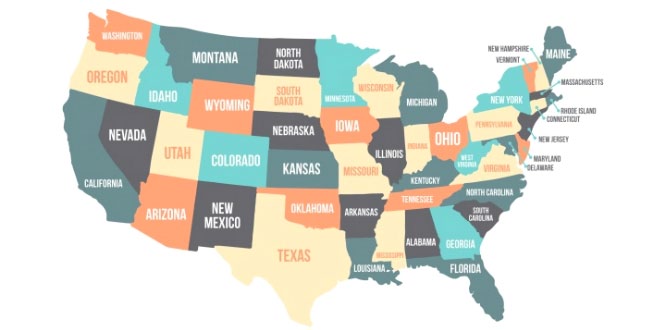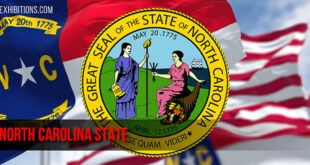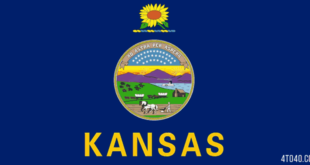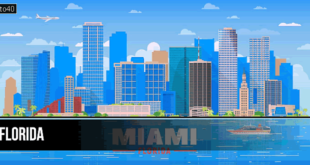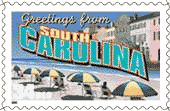
The capital of South Carolina State is COLUMBIA, located in the geographic center of the state. The state’s name is derived from Charles I of England, who granted “Carolina” in 1629 to Sir Robert Heath. The first permanent European settlement was at Charles Town–renamed CHARLESTON in 1783 — in early 1670. South Carolina State assumed a position of political and social leadership during the colonial, revolutionary, and antebellum periods. The post-Civil War era and the early 20th century witnessed a severe social and economic decline in the state, but the rise of the New South in the last few decades has renewed the state’s vitality.
South Carolina: Land & Resources
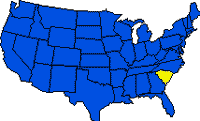 South Carolina can be divided into three physiographic regions. The Coastal Plain, the largest and geologically youngest region, extends from the Sea Islands inland to the Sand Hills. The topography is flat near the coast but more rolling in the interior, where elevations reach 92 m (302 ft). Sandy barrier islands, many of which are being eroded, and salt marshes, covered by salt-marsh grass and black needle rush, constitute the common coastal environment. Old beach ridges are covered with maritime forests of palmetto (the state tree), live oak, loblolly pine, and wax myrtle. In the outer Coastal Plain, especially along rivers, numerous swamps support bald cypress, swamp tupelo, water oak, and willow trees. A physiographic feature unique to the plain is the many Carolina Bays, whose origin is still unknown. These elliptical bogs or lakes have a northwest-southeast axis and are bordered, predominately on the eastern quadrant, by a sand rim. Characteristic vegetation includes sweet and red bay (for which the feature is named), cypress, loblolly pine, and sweet gum. The Coastal Plain culminates in the Sand Hills, which extend from Aiken northeastward through Columbia to Cheraw. The sandy soils of these hills support scrub oak, blackjack oak, and longleaf pine.
South Carolina can be divided into three physiographic regions. The Coastal Plain, the largest and geologically youngest region, extends from the Sea Islands inland to the Sand Hills. The topography is flat near the coast but more rolling in the interior, where elevations reach 92 m (302 ft). Sandy barrier islands, many of which are being eroded, and salt marshes, covered by salt-marsh grass and black needle rush, constitute the common coastal environment. Old beach ridges are covered with maritime forests of palmetto (the state tree), live oak, loblolly pine, and wax myrtle. In the outer Coastal Plain, especially along rivers, numerous swamps support bald cypress, swamp tupelo, water oak, and willow trees. A physiographic feature unique to the plain is the many Carolina Bays, whose origin is still unknown. These elliptical bogs or lakes have a northwest-southeast axis and are bordered, predominately on the eastern quadrant, by a sand rim. Characteristic vegetation includes sweet and red bay (for which the feature is named), cypress, loblolly pine, and sweet gum. The Coastal Plain culminates in the Sand Hills, which extend from Aiken northeastward through Columbia to Cheraw. The sandy soils of these hills support scrub oak, blackjack oak, and longleaf pine.
The PIEDMONT rises from the FALL LINE, which marks the boundary with the Coastal Plain, to an elevation of about 427 m (1,401 ft). Streams have cut deeply into the surface and left a rolling-to-hilly topography. Severe-to-moderate erosion, which followed extensive agricultural clearing, removed much of the topsoil and left the heavy red-clay subsoil now characteristic of the region. Native vegetation is basically hardwood: black, white, and red oak; pignut hickory; and dogwood. Shortleaf pine also grows in the Piedmont. Along streams cottonwood, yellow poplar, willow, sycamore, and sweet gum are common. The loblolly pine, which is not native to the Piedmont, has been widely planted for pulpwood.
The BLUE RIDGE MOUNTAINS occupy a small portion of the northwest corner of the state. Elevations vary from 427 m (1,401 ft) to 1,085 m (3,560 ft) at Sassafras Mountain, the highest point in South Carolina. The thin, well-drained soils of the steep slopes are clayey to loamy.
Climate
Average temperatures in January vary from 11 deg C (51 deg F) in Charleston to 7 deg C (44 deg F) in Greenville-Spartanburg. July averages are 26 deg C (79 deg F) in Greenville-Spartanburg and 28 deg C (82 deg F) in Charleston. The mean annual precipitation throughout the state totals 1,295 mm (51 in). Adequate rainfall complements a growing season of 290 days on the southern coast and more than 200 days in the northwest. Hurricanes occasionally threaten the coast.
Tourism
Tourism is an increasingly important industry in the state. More than three-fourths of the vacation spending is at Charleston and the resorts of Myrtle Beach and Hilton Head Island. Other major attractions are the Cowpens National Battlefield and Fort Sumter and Kings Mountain military sites.
South Carolina State: History
About 25 or 30 distinct native tribes lived in South Carolina at the time of first European contact. The major groups were the CHEROKEE, the CATAWBA, and the YAMASEE. By 1800 virtually all had been driven from the state.
Francisco Gordillo was the first European to visit South Carolina in 1521. The Spanish attempted the first European settlement near present-day Georgetown in 1526, but it failed after 9 months. In 1663, King Charles II of England granted the territory that now comprises both North and South Carolina to eight lords proprietors, one of whom was Anthony Ashley Cooper, later 1st earl of Shaftesbury. The first permanent settlement, at Charles Town (Charleston) on the Ashley River, was established by the English in 1670. (It was moved in 1680 to the peninsula between the Cooper and Ashley rivers.) At first the new colony of Carolina was economically dependent on furs and skins from the Indian trade and on forest products such as lumber, resin, and turpentine. By the end of the 17th century, experiments with rice cultivation proved successful, and it became the leading crop of colonial Carolina, complemented after 1744 by indigo. The wealth derived from these crops supported the colony’s cultural and intellectual efflorescence. Settlement spread from Charles Town south toward BEAUFORT (founded 1710), north toward Georgetown (1735), and inland along the rivers.
By the 1750s, Germans and Scottish-Irish from Pennsylvania and Virginia were settling the Piedmont on small, subsistence farms in contrast to the coastal plantations. The pre-Revolutionary period (1725-75) was a prosperous one based on pelts and the rapidly expanding rice and indigo crops. The Southern Indian trade and agricultural exporting centered on Charleston, which became an increasingly rich and important port. The colony became more and more independent as the British did little to exercise control.
South Carolina was early in resisting British rule. In 1693 the colony won the right to initiate legislation in the British House of Commons. In 1704 an act that would have required members of the colonial assembly to adhere to the rites of the Church of England was defeated. The church was, however, made official in 1706 and remained so until 1778. In 1719 the populace rebelled against the British proprietors and their reactionary policies, expelling them and electing James Moore as governor. As a result the British crown assumed (1729) jurisdiction, and North and South Carolina were constituted as separate colonies. A survey of the boundary between the two, begun in 1735, was not completed until 1815.
The Revolutionary War, after the British repulse at Charleston in 1776, temporarily bypassed South Carolina. Then the British captured Charleston on May 12, 1780. The numerous battles and skirmishes fought in the state after 1780 included important American victories at Kings Mountain and Cowpens (see COWPENS, BATTLE OF).
South Carolina was the eighth state to ratify the federal Constitution, on May 23, 1788. To mollify Piedmont settlers, who demanded increased representation, the General Assembly agreed in 1786 to move the capital. Columbia was established as the new seat of government. In the first federal census of 1790, South Carolina’s population of 249,073 ranked 7th. Nonwhites accounted for 43.7% of the total and were concentrated in the low country around Charleston.
Of major economic importance was the adoption at the end of the 18th century of short-staple, green-seed cotton. It was grown increasingly in the interior, and the cotton gin, greater European demand, and improved transportation (the canal system and river improvements began in 1795) made it a viable economic staple. Its success turned many Piedmont farmers into slave-holding planters and unified the state economically, socially, and politically.
During the 1820s and ’30s cotton prices collapsed, and the state’s economy and population growth stagnated. Blaming these problems on the national tariff policies, South Carolina–led by Vice-President John C. CALHOUN–asserted its right to nullify federal legislation. In 1832 a special state convention nullified the Tariff Act of that year. President Andrew Jackson responded to this action with a Force Act. The NULLIFICATION crisis was resolved by compromise, but STATE RIGHTS sentiment continued to grow in South Carolina.
Dissatisfaction culminated in the convention that, on Dec. 20, 1860, voted to remove South Carolina from the Union, the first Southern state to secede. The Civil War began on Apr. 12, 1861, with the firing on Fort Sumter in Charleston Harbor. Beaufort and Port Royal fell to Union forces on Nov. 7, 1861, but not until Sherman’s invasion of the state at the beginning of 1865 was the impact of war felt. Severity of property loss, however, paled before the mortality figures for South Carolina: about 25% of the 63,000 who served were killed.
Reconstruction was hard on South Carolina, and corrupt officials left the state with heavy debts. The election of Wade HAMPTON (1818-1902) as governor in 1876 and removal of federal troops by President Rutherford Hayes ended congressional Reconstruction.
Poor cotton prices and severe soil erosion after 1880 stymied economic improvement, and agricultural distress led to political success for the farmers’ movement. Its leader, Benjamin Ryan TILLMAN, was elected to the governor’s post (1890-94) and the U.S. Senate (1895-1918). A state constitutional convention in 1895 largely disenfranchised blacks. Strong populist leanings characterized South Carolina’s politics for decades.
By 1910 rice production had virtually disappeared, although cotton remained the state’s leading crop into the 1950s. During the late 19th century the tenant system developed, and in 1930 it characterized 65% of the state’s farms. During the early 20th century urban concentrations developed around Piedmont textile centers such as Greenville and Spartanburg, and the out-migration of blacks reduced their percentage of the population.
World War I temporarily revived agricultural fortunes, but an economic depression, which lasted for two decades, and infestation by the boll weevil, which destroyed half the cotton crop, began in 1921. World War II was a watershed in South Carolina’s history, enormously increasing emphasis on industrialization. By the early 1950s the state was actively seeking industry to complement the textile mills that had virtually monopolized the nonagricultural sector of its economy. This, complemented by a diversifying agricultural base, underpinned an expanding economy.
Despite the 1954 Supreme Court decision (see BROWN V. BOARD OF EDUCATION OF TOPEKA, KANSAS), South Carolina initially resisted racial integration. In the 1960s, however, under the leadership of moderate governors, school integration was achieved. Hurricane Hugo in 1989 did much damage in a dozen of the state’s counties.
South Carolina State: Land
- Area: 82,898 sq km (32,007 sq mi); rank: 40th.
- Capital and largest city: Columbia (1990 census, 98,052).
- Counties: 46.
- Elevations: highest–1,085 m (3,560 ft), at Sassafras Mountain; lowest–sea level, at the Atlantic coast.
South Carolina State Symbols:
Flag:

Statehood:
May 23, 1788; the 8th state
Nickname:
Palmetto State
Bird:

Tree:
Palmetto
Flower:

Motto:
Animis Opibusque Parati (“Prepared in Mind and Resources”) and Dum spiro spero (“While I breathe, I hope”)
Song:
“Carolina”
 Kids Portal For Parents India Kids Network
Kids Portal For Parents India Kids Network
